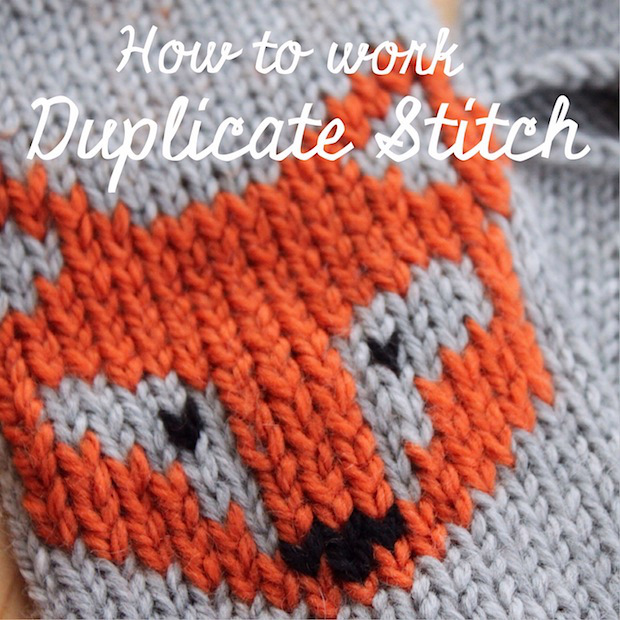
So, when knitting flat, the +1 will give you a selvage of one knit stitch on both sides of the repeat. Now here comes the hard part about casting on. So, like someone else already pointed out, row4 was missing a “k2” at the very end. That’s why, in R4, it says “purl 3” instead of just one. The basic repeat of the start stitch is *p1, * and you are off-setting that repeat by 2 stitches every pattern row. Well…this is a difficult question really and there is no right and wrong answer. Step 4: Secure the yarn over with your right index finger and now purl 3 together into the same 3 stitches again. Step 3: Now you have to yarn over purlwise once. Step 2: Purl these three stitches together BUT DON’T SLIP THE STITCH. Step 1: Insert the right needle into the first three stitches on your left needle.
#KNITTING DUPLICATE STITCH HOW TO#
You can catch up on how to purl stitch here, and here’s a tutorial for the knit stitch. I’m just going to show you how to knit the star stitch here. But if you are an intermediate English knitter, I’m sure you can adapt it. I am a continental knitter, so I am going to show you how to knit the start stitch the continental way. It’s maybe a bit slower to knit, but if this instruction didn’t make any sense to you, read on to view the close-up pictures. I know, this sounds quite difficult, but it really isn’t. The star stitch is an easy 4-row repeat where the iconic stars are knitted from the wrong side. If you are looking for a similar-looking reversible pattern the moss stitch might be a good option for you. Note: The star stitch is not a reversible pattern. In knitting pattern, the star stitch is often also called Daisy Stitch or Flat Knot. It’s maybe not the best beginner stitch but once you get the hang of it, it’s pretty smooth knitting. So, it can be the ideal pattern for a little baby blanket or a warm sweater. It’s not all that stretchy, rather solid, and pretty thick. The star stitch creates very beautiful fabric with a lot of texture. So, you want to knit a project in the star stitch but you don’t know how? Well, you came to the right place! In this tutorial, I’m not only going to show you the repeat but also provide you with step-by-step instruction with extra-large pictures, as this stitch is a bit more difficult to explain and knit. I hope this tutorial has been helpful! If you would like to see how I use this same technique in stockinette stitch, you can see my video here where I was doing so on my Audrey’s Cardigan (video starts at duplicate stitch part).A step-by-step tutorial on the star stitch knitting pattern with detailed instructions for beginners. Below are the individual steps I will now work (they are the exact same as the above garter stitch version, just going in a different direction): Just like in garter stitch, the “ path of the stitch” is outlined in red above and the black arrows show you the direction in which I’ll be going. Additionally, I’ll be showing it to you going in a different direction (going in the left direction instead of the right direction – either works in duplicate stitch). It’s the exact same technique, but it looks different because of the stitch pattern. Then I just snip my end! Now let me show you show how this looks on the wrong-side of Stockinette stitch.

Last photo shows how well hidden your end is now! How many stitches I “duplicate” when weaving in an end depends on the type of fiber and thickness, but typically it’s anywhere between 2-4 stitches. Step 6: You’ll thread yarn through both stitches and then insert needle downwards just as you did in step 2 and 3.Step 5: You’ll then continue to next stitch, inserting needle upwards into next bottom loop and loop above as you did in Step 1.Step 4: Then thread yarn through both stitches.Step 3: Then insert needle downwards, into next loop and then back into same bottom loop as Step 1.



 0 kommentar(er)
0 kommentar(er)
